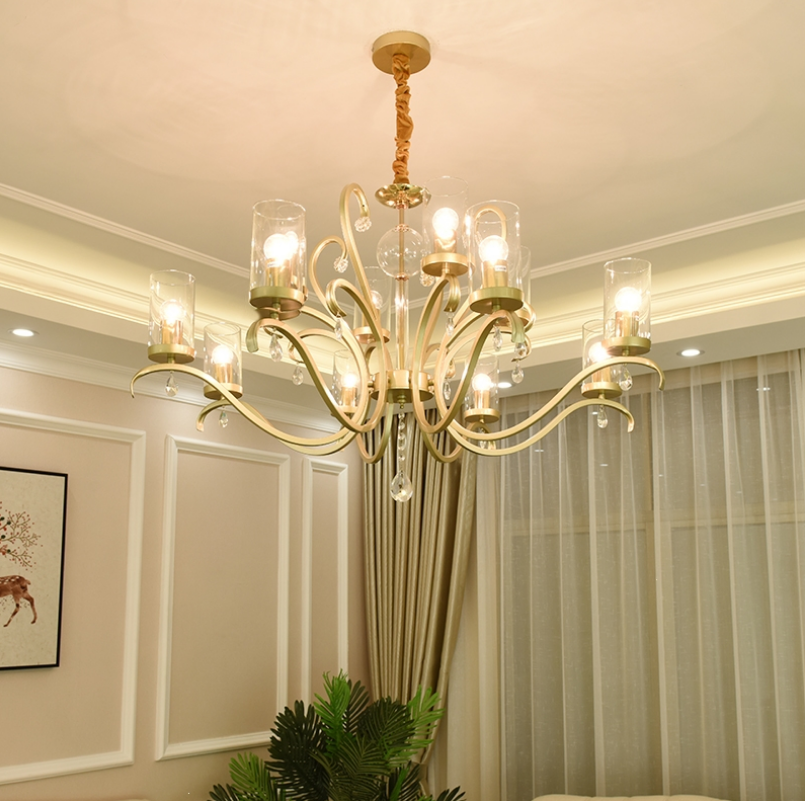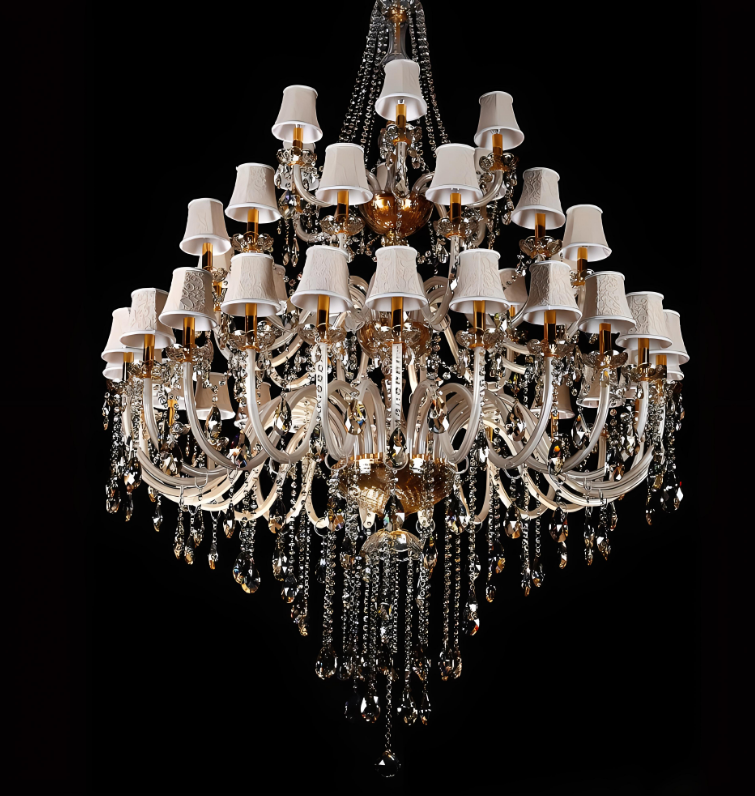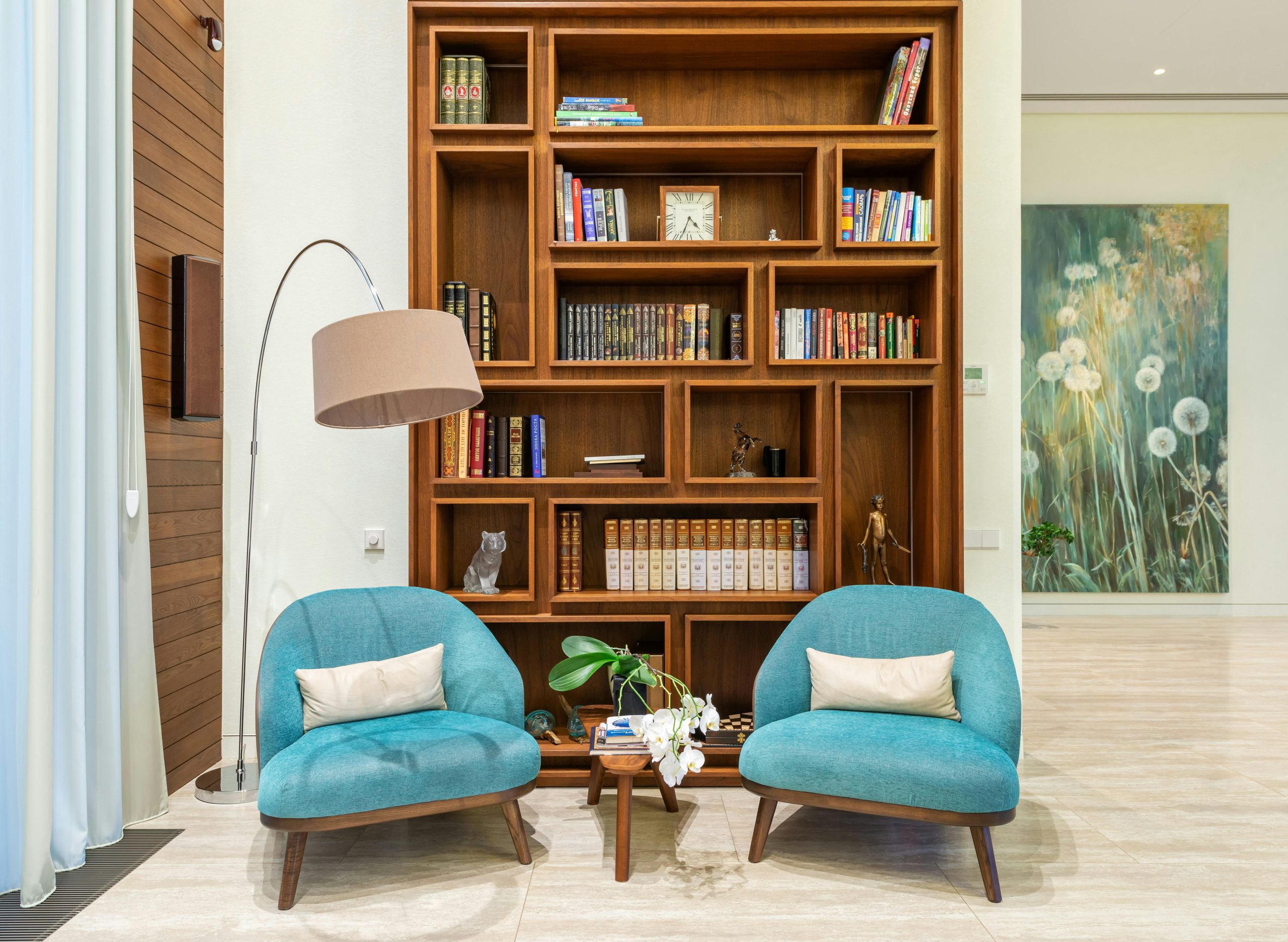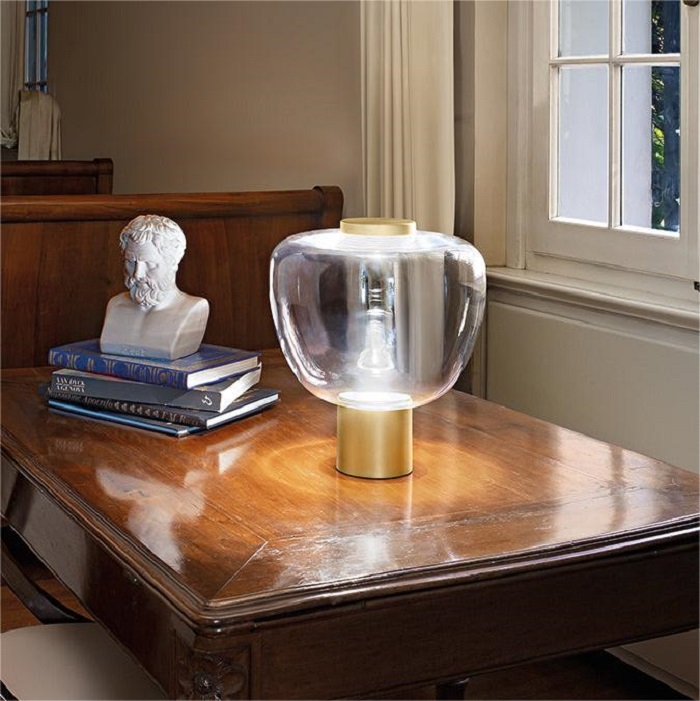Chandeliers have a rich and fascinating history that dates back to ancient times. The word “chandelier” is derived from the French word “chandelle,” which means candle. The earliest chandeliers were simple wooden crosses with spikes to hold candles, and they were used to illuminate large rooms and halls in medieval times. As technology advanced, chandeliers evolved to incorporate metal frames and more elaborate designs. In the 15th century, glassmaking techniques improved, leading to the creation of glass chandeliers adorned with intricate patterns and designs. These luxurious fixtures became a symbol of wealth and status, adorning the palaces and grand homes of royalty and aristocrats.
During the 18th century, chandeliers underwent another transformation with the introduction of crystal prisms. This innovation allowed chandeliers to refract light and create dazzling displays, adding a touch of glamour and opulence to any space. The Industrial Revolution brought further advancements in chandelier production, with the use of gas and later electricity to illuminate the fixtures. This made chandeliers more accessible to the middle class, and they became a popular choice for lighting in homes and public buildings. Today, chandeliers continue to be a timeless and elegant lighting option, with modern designs incorporating a wide range of materials and styles to suit any decor.
Chandeliers have a long and storied history, evolving from simple wooden structures with candles to elaborate crystal-adorned fixtures that symbolize luxury and sophistication. The evolution of chandeliers reflects advancements in technology, design, and craftsmanship throughout the centuries, making them a timeless and enduring lighting choice for any space.Ateasehomelife
The Versatility of Chandeliers in Home Decor
Chandeliers are incredibly versatile fixtures that can enhance the aesthetic appeal of any room in a home. Their ability to serve as a focal point or complement existing decor makes them a popular choice for interior designers and homeowners alike. In a grand foyer or entryway, a large chandelier can make a bold statement and set the tone for the rest of the home. Its presence can create a sense of grandeur and elegance, welcoming guests with a touch of luxury. In dining rooms, chandeliers are often used to illuminate the space while adding a touch of sophistication to formal gatherings. The right chandelier can enhance the ambiance of the room, making it an inviting and stylish space for entertaining.
In living rooms and bedrooms, chandeliers can add a touch of glamour and romance. Whether it’s a modern, minimalist design or a vintage-inspired crystal fixture, a chandelier can elevate the overall aesthetic of the room and create a sense of luxury. Additionally, chandeliers are not limited to traditional spaces; they can also be used in unexpected ways to add drama and flair to kitchens, bathrooms, and even outdoor living areas. With a wide range of styles, sizes, and materials available, there is a chandelier to suit every taste and decor style, making it a versatile and timeless lighting option for any home.
Chandeliers are incredibly versatile fixtures that can enhance the aesthetic appeal of any room in a home. Their ability to serve as a focal point or complement existing decor makes them a popular choice for interior designers and homeowners alike. In a grand foyer or entryway, a large chandelier can make a bold statement and set the tone for the rest of the home. Its presence can create a sense of grandeur and elegance, welcoming guests with a touch of luxury. In dining rooms, chandeliers are often used to illuminate the space while adding a touch of sophistication to formal gatherings. The right chandelier can enhance the ambiance of the room, making it an inviting and stylish space for entertaining.
In living rooms and bedrooms, chandeliers can add a touch of glamour and romance. Whether it’s a modern, minimalist design or a vintage-inspired crystal fixture, a chandelier can elevate the overall aesthetic of the room and create a sense of luxury. Additionally, chandeliers are not limited to traditional spaces; they can also be used in unexpected ways to add drama and flair to kitchens, bathrooms, and even outdoor living areas. With a wide range of styles, sizes, and materials available, there is a chandelier to suit every taste and decor style, making it a versatile and timeless lighting option for any home.
How to Choose the Right Chandelier for Your Space
Choosing the right chandelier for your space is essential to achieving the desired aesthetic and functionality. There are several factors to consider when selecting a chandelier, including the size of the room, the height of the ceiling, the style of decor, and the intended use of the space. One of the most critical considerations is the size of the chandelier in relation to the room. A general rule of thumb is to add the dimensions of the room together in feet and then convert that number to inches to determine the ideal diameter of the chandelier. For example, a room that is 12 feet by 14 feet would require a chandelier with a diameter of 26 inches.
The height of the ceiling also plays a significant role in choosing the right chandelier. For rooms with standard 8-foot ceilings, it’s essential to select a chandelier that doesn’t hang too low and impede movement. Conversely, rooms with higher ceilings offer more flexibility in terms of chandelier size and height. The style of decor in the room should also influence your choice of chandelier. For traditional or formal spaces, crystal or ornate chandeliers may be more appropriate, while modern or minimalist rooms may benefit from sleeker, more streamlined designs. Finally, consider how the space will be used when selecting a chandelier. Dining rooms may require brighter illumination for entertaining, while bedrooms may benefit from softer, more ambient lighting.
Choosing the right chandelier for your space is essential to achieving the desired aesthetic and functionality. There are several factors to consider when selecting a chandelier, including the size of the room, the height of the ceiling, the style of decor, and the intended use of the space. One of the most critical considerations is the size of the chandelier in relation to the room. A general rule of thumb is to add the dimensions of the room together in feet and then convert that number to inches to determine the ideal diameter of the chandelier. For example, a room that is 12 feet by 14 feet would require a chandelier with a diameter of 26 inches.
The height of the ceiling also plays a significant role in choosing the right chandelier. For rooms with standard 8-foot ceilings, it’s essential to select a chandelier that doesn’t hang too low and impede movement. Conversely, rooms with higher ceilings offer more flexibility in terms of chandelier size and height. The style of decor in the room should also influence your choice of chandelier. For traditional or formal spaces, crystal or ornate chandeliers may be more appropriate, while modern or minimalist rooms may benefit from sleeker, more streamlined designs. Finally, consider how the space will be used when selecting a chandelier. Dining rooms may require brighter illumination for entertaining, while bedrooms may benefit from softer, more ambient lighting.
The Different Types of Chandeliers and Their Unique Features
Chandeliers come in various styles and designs, each with its unique features that cater to different tastes and decor preferences. Traditional chandeliers often feature ornate metalwork and intricate crystal embellishments that exude elegance and opulence. These fixtures are perfect for formal dining rooms or grand foyers where they can make a bold statement and create an atmosphere of luxury. Modern chandeliers, on the other hand, embrace sleek lines, minimalist designs, and innovative materials such as glass or metal. These fixtures are ideal for contemporary spaces that demand clean aesthetics and understated sophistication.
Crystal chandeliers remain one of the most popular choices for those seeking timeless elegance and glamour in their homes. The use of crystal prisms refracts light beautifully, creating dazzling displays that add an air of luxury to any room. Rustic or farmhouse-style chandeliers feature distressed wood or wrought iron elements that bring warmth and charm to spaces such as kitchens or living rooms. These fixtures often incorporate candelabra-style lights for a cozy and inviting ambiance. Finally, mini-chandeliers are perfect for smaller spaces or as accent lighting in areas such as walk-in closets or bathrooms. These petite fixtures offer all the elegance and charm of larger chandeliers but on a smaller scale.
Chandeliers come in various styles and designs, each with its unique features that cater to different tastes and decor preferences. Traditional chandeliers often feature ornate metalwork and intricate crystal embellishments that exude elegance and opulence. These fixtures are perfect for formal dining rooms or grand foyers where they can make a bold statement and create an atmosphere of luxury. Modern chandeliers, on the other hand, embrace sleek lines, minimalist designs, and innovative materials such as glass or metal. These fixtures are ideal for contemporary spaces that demand clean aesthetics and understated sophistication.
Crystal chandeliers remain one of the most popular choices for those seeking timeless elegance and glamour in their homes. The use of crystal prisms refracts light beautifully, creating dazzling displays that add an air of luxury to any room. Rustic or farmhouse-style chandeliers feature distressed wood or wrought iron elements that bring warmth and charm to spaces such as kitchens or living rooms. These fixtures often incorporate candelabra-style lights for a cozy and inviting ambiance. Finally, mini-chandeliers are perfect for smaller spaces or as accent lighting in areas such as walk-in closets or bathrooms. These petite fixtures offer all the elegance and charm of larger chandeliers but on a smaller scale.
Maintaining and Cleaning Chandeliers for Longevity
Proper maintenance and cleaning are essential for preserving the beauty and functionality of chandeliers over time. Dust accumulation can dull crystal prisms or dim light output, so regular cleaning is necessary to keep them looking their best. Before cleaning your chandelier, ensure that it is turned off and cool to avoid any risk of electrical shock or damage. Use a soft microfiber cloth or duster to gently remove dust from each crystal prism or glass component. For more thorough cleaning, mix warm water with mild dish soap in a spray bottle and lightly mist the crystals before wiping them clean with a soft cloth.
For metal components such as frames or chains, use a metal cleaner appropriate for the specific material (e.g., brass cleaner for brass fixtures). Be sure to follow manufacturer instructions carefully to avoid damaging the finish. It’s also essential to inspect your chandelier regularly for any loose or damaged parts that may need repair or replacement. If you’re unsure about how to clean or maintain your specific type of chandelier, consult with a professional lighting specialist who can provide guidance on proper care techniques.
Proper maintenance and cleaning are essential for preserving the beauty and functionality of chandeliers over time. Dust accumulation can dull crystal prisms or dim light output, so regular cleaning is necessary to keep them looking their best. Before cleaning your chandelier, ensure that it is turned off and cool to avoid any risk of electrical shock or damage. Use a soft microfiber cloth or duster to gently remove dust from each crystal prism or glass component. For more thorough cleaning, mix warm water with mild dish soap in a spray bottle and lightly mist the crystals before wiping them clean with a soft cloth.
For metal components such as frames or chains, use a metal cleaner appropriate for the specific material (e.g., brass cleaner for brass fixtures). Be sure to follow manufacturer instructions carefully to avoid damaging the finish. It’s also essential to inspect your chandelier regularly for any loose or damaged parts that may need repair or replacement. If you’re unsure about how to clean or maintain your specific type of chandelier, consult with a professional lighting specialist who can provide guidance on proper care techniques.
The Role of Chandeliers in Interior Design

Chandeliers play an integral role in interior design by serving as both functional lighting fixtures and decorative elements that enhance the overall aesthetic appeal of a space. Their ability to create ambiance through light refraction makes them an essential component in setting the mood for various rooms within a home. In addition to providing illumination, chandeliers also act as focal points that draw attention upward toward architectural features such as high ceilings or decorative moldings.
The style and design of a chandelier can significantly impact the overall look and feel of a room; whether it’s adding an element of grandeur in formal spaces or infusing modern sophistication into contemporary interiors. Chandeliers also offer an opportunity for personal expression through their diverse range of styles, materials, and sizes that cater to individual tastes and decor preferences.
Chandeliers play an integral role in interior design by serving as both functional lighting fixtures and decorative elements that enhance the overall aesthetic appeal of a space. Their ability to create ambiance through light refraction makes them an essential component in setting the mood for various rooms within a home. In addition to providing illumination, chandeliers also act as focal points that draw attention upward toward architectural features such as high ceilings or decorative moldings.
The style and design of a chandelier can significantly impact the overall look and feel of a room; whether it’s adding an element of grandeur in formal spaces or infusing modern sophistication into contemporary interiors. Chandeliers also offer an opportunity for personal expression through their diverse range of styles, materials, and sizes that cater to individual tastes and decor preferences.
The Future of Chandeliers: Modern Innovations and Trends
As technology continues to advance at an unprecedented pace, so too do innovations in lighting design including modern advancements in chandelier technology have led to exciting new possibilities for incorporating these fixtures into contemporary spaces.
One notable trend is the integration of smart lighting features into chandeliers allowing users to control brightness levels color temperatures through mobile devices or voice commands this level convenience flexibility has made smart chandeliers increasingly popular among homeowners seeking modern solutions for their lighting needs.
Another emerging trend is eco-friendly design which has led manufacturers develop energy-efficient LED options reduce power consumption while still delivering ample illumination these sustainable choices align with growing emphasis on environmental responsibility within interior design industry.
As technology continues to advance at an unprecedented pace so too do innovations in lighting design including modern advancements in chandelier technology have led exciting new possibilities for incorporating these fixtures into contemporary spaces.
One notable trend is integration smart lighting features into chandeliers allowing users control brightness levels color temperatures through mobile devices voice commands this level convenience flexibility has made smart increasingly popular among homeowners seeking modern solutions their lighting needs.
Another emerging trend eco-friendly design which has led manufacturers develop energy-efficient LED options reduce power consumption while still delivering ample illumination these sustainable choices align growing emphasis on environmental responsibility within interior design industry . LED lighting is not only energy-efficient, but also long-lasting, reducing the need for frequent replacements and further minimizing waste. Additionally, the use of sustainable materials and non-toxic finishes in furniture and decor is becoming increasingly popular, as designers and consumers alike seek to minimize their environmental impact. This shift towards eco-friendly design reflects a broader cultural shift towards sustainability and a desire to create spaces that are not only aesthetically pleasing, but also environmentally responsible.





